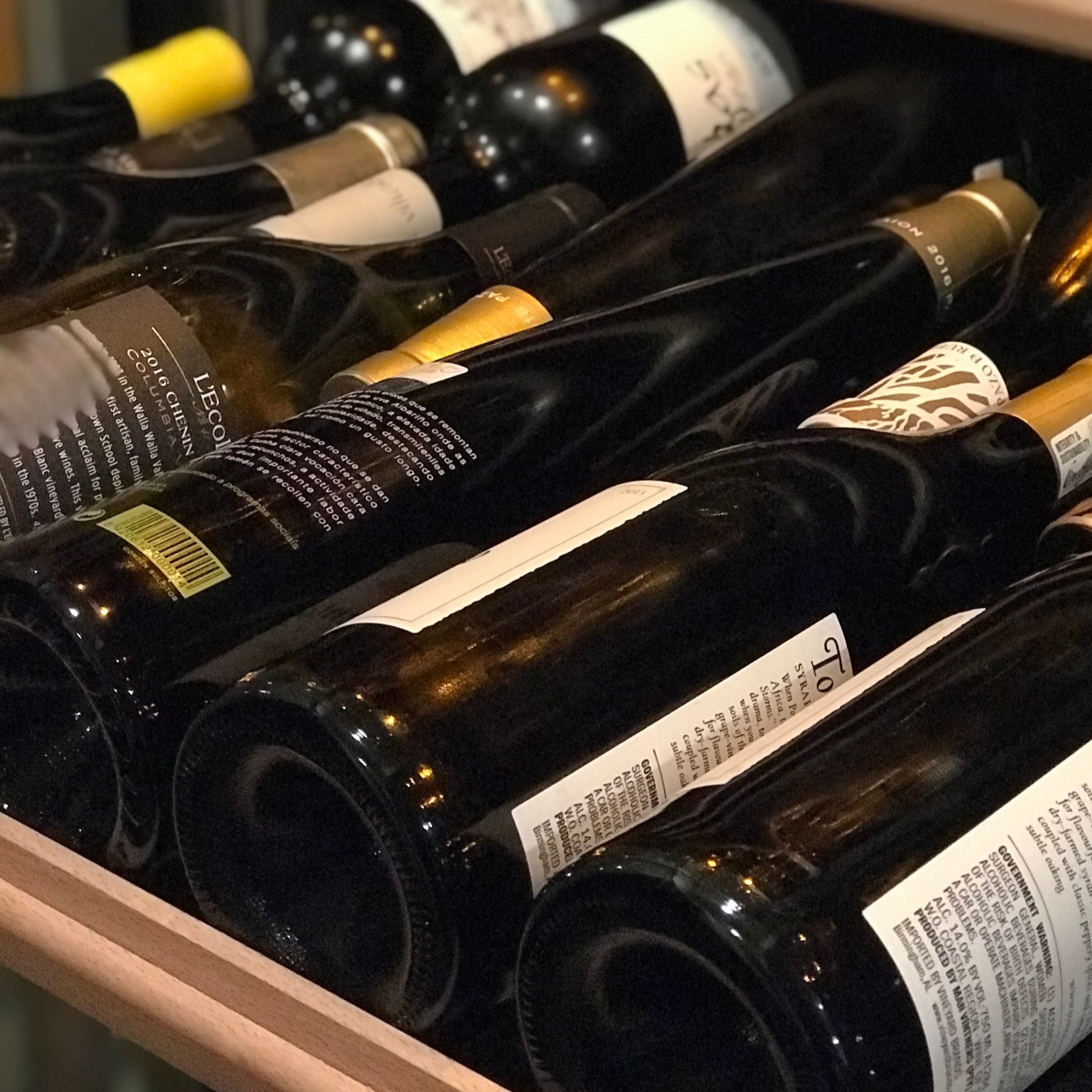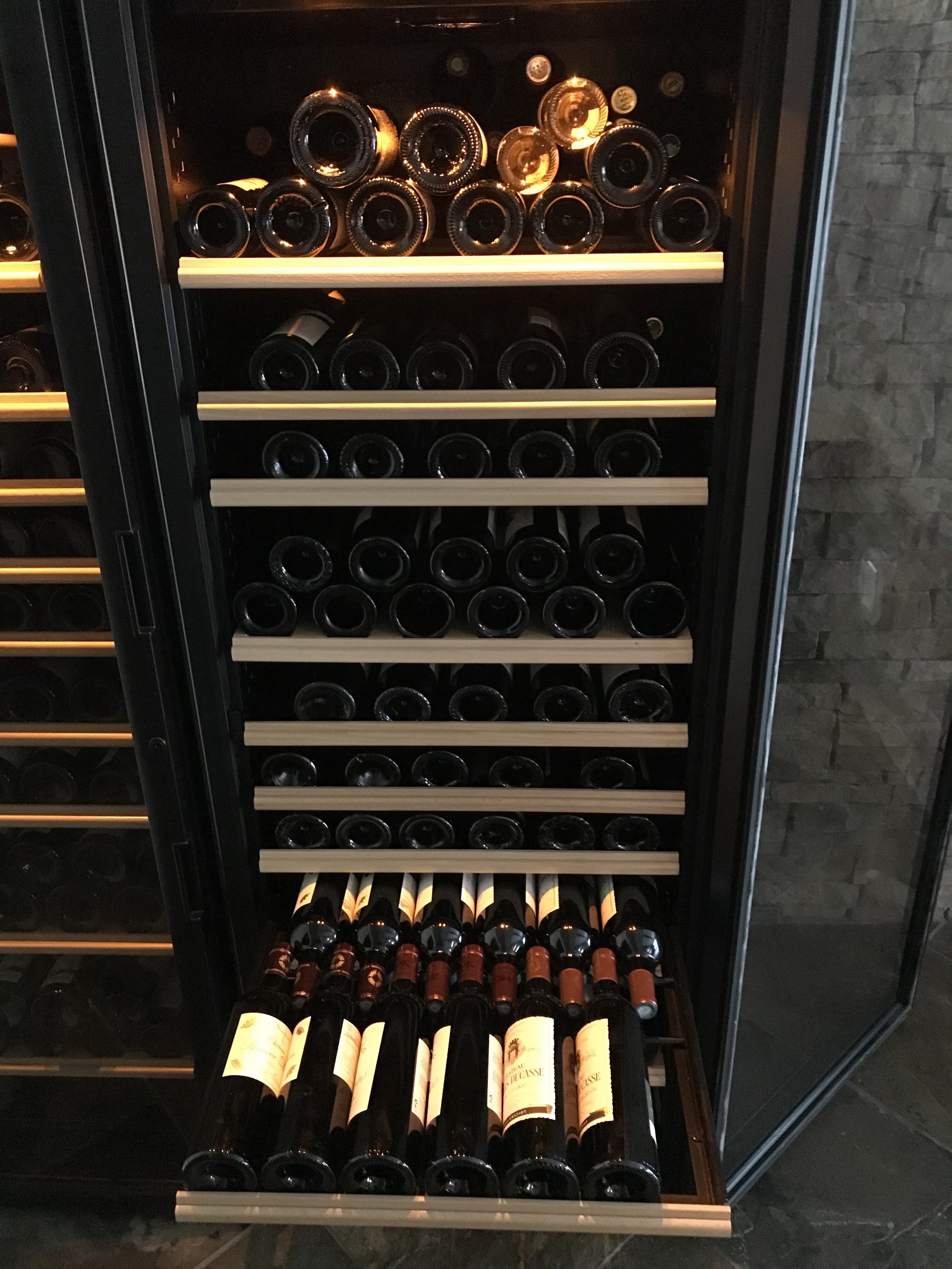The EuroCave wine cabinet is a big investment, and we know that fellow consumers want to be certain they are making the right choice. In our experience, it is common to find product reviews immediately following delivery and installation, with the excitement of the purchase still fresh in their minds. Here, we’re pleased to be providing a review after five years of EuroCave use (we purchased two EuroCave Performance 283 units in 2014).
At the time of purchase, we couldn’t find a lot of online information on EuroCaves. However, we’d been to Europe a few times and had seen the EuroCave in wine bars and restaurants. Their design and quietness stood out to us.
As our wine collection grew, we had to choose between storing wine in the basement at ambient temperature in our Wine Racks Americas wooden wine racks or take the plunge and purchase a large wine maturation cabinet. Looking back, we wish we’d committed to a EuroCave much earlier!
The EuroCave Performance 259 Built-In Wine Cellar:
Who is EuroCave?
EuroCave Group is an innovative French company with over 40 years in the wine cabinet business. The EuroCave brand came into being in 1976, just after the invention of the wine cabinet in 1975. EuroCave saw that wine lovers and collectors had a desire to store wines somewhere other than an actual cave for improved storage conditions.
EuroCave Group has four brands, two of which are targeted for the home consumer:
EuroCave: Sold and distributed throughout Europe and globally. This brand includes wine cabinets, wine cellar conditioners, and storage systems. These units typically have 5-year warranties.
ArteVino: Large wine maturation cabinets sold and distributed to select large online retailers and select big-box stores in both France and the United States. These units typically have 2-year warranties.
With over 20 patents in wine cabinets, partners with a university in France on wine maturation research. They also have strong distribution in large wine consuming countries like France, United States, Australia, and Asia.
What is a EuroCave?
In the United States, people use “EuroCave” colloquially to refer to the gold standard of wine maturation cabinets. These same units can also be maintained to keep wine at serving temperature - slightly higher than during wine maturation. The temperature setting depends upon your desire - bottle aging or serving!
Physically, EuroCave wine maturation units are comprised of a cabinet body, control panel, lighting, glass door, bracing, storage shelves and racks, humidity cartridges, breathing hole, adjustable feet, temperature sensors, hygrometer, and hinges.
The EuroCave provides temperature, humidity, air circulation, vibration, and a light-controlled environment to mimic the natural cave-like environment ideal for bottle aging. Read more about the impacts on these environmental impacts in our review of the best small wine refrigerators.
The name EuroCave is typically considered a premium, long-lasting, durable goods producer. Premium durable goods for the home often contain the same components as a EuroCave: metal-versus-plastic components, luxurious look and feel, quiet operation, above-average mechanics like compressors, and seamless integration of cabinet components.
Large EuroCave maturation cabinets like the EuroCave 283 are likely not a fit for wine collectors who have small collections under 50 bottles, who drink most of the wine that they purchase within a year, and who are living in small spaces. The EuroCave is also not suitably installed in areas that are poorly ventilated, prone to flooding, have uneven floors, or sustain temperatures spiking above 35 C (95 F) or dipping below 12 C (54 F).
Pros of the EuroCave Performance
Robust walls, wooden shelves
Wood-framed metal rolling racks with plastic individual bottle cradles
Very quiet compressor (“library quiet”)
Easy to make minor repairs by oneself
Sleek, modern look
5-year warranty
Less expensive than building a stone-walled cellar
Cons of the EuroCave 283
Difficult (not impossible) to move (they weigh over 200 pounds)
It’s difficult to know the exact number of wine bottles you can get in the unit due to the variability in bottle sizes common in the wine trade
Features and Benefits of The EuroCave Performance
The EuroCave Performance minimizes the environmental impact to wine in the six areas of concern for wine collectors (temperature, humidity, UV light, vibration, air circulation, and storage). Here’s why we love the EuroCave Performance, in relation to those areas of concern. The EuroCave Performance:
Maintains a constant temperature.
Maintains a consistent humidity level inside the chamber between 50% and 75%.
Uses tempered glass to protect wine from UV light.
Has anti-vibration technology to reduce vibration.
Circulates fresh air to reduce the likelihood of mold, acting as a natural cellar.
Convenient shelving system reduces need to move the bottles around too much.
EuroCave Temperature Setting
After using two EuroCave 283s for the past five years, we have experienced no issues with temperature fluctuation. Setting the temperature is very easy. It is adjustable, but we leave ours set at the default temperature of 12C (54 F).
The best way to reduce the chances of temperature fluctuation is to install the cabinet in an area that does not see a lot of temperature fluctuation. This EuroCave should reside in a space that is between 12 C and 35 C as ambient temperature.
Of note, the EuroCaves are one-temperature cabinets. If one chooses, they could easily convert the wine cabinet to be a wine serving cabinet, meaning one could adjust the temperature to 18 C for serving a red wine directly from it for a big party.
What ambient temperatures are required for the EuroCave?
In order for the cabinet to operate properly, the ideal ambient temperature of the room should be 12 C to 35 C. We would not recommend installing a EuroCave in a garage in most climates due to these risks. Large appliances in extreme temperatures simply do not last very long.
Where is the EuroCave made?
The EuroCave is made in France in two locations: Fourmie and Pont de Chéruy.
What are EuroCave walls made of?
The EuroCave Performance 283 walls are constructed of aluminum. Some models include a body stiffener, which is essentially a metal brace reinforcing the side walls.
What accessories come with the EuroCave?
The Performance EuroCave comes with an open door alarm, sensor fault alarm, temperature alarm, charcoal filter alarm, digital setting and selection keys, button to adjust light mode, a humidity display, and temperature display, standby key, and hot and cold circuit indicators.
When purchasing, one has the ability to select, with some constraints, the number of rolling shelves and wooden racks.
User instructions also came in six languages with plenty of black and white photos and descriptions of components and descriptions of what the different display items mean.
There is also a EuroCave App. I did not choose to use the App as I already had an inventory in the CellarTracker App and like other features of CellarTracker.
What maintenance is required on the EuroCave?
The maintenance has been minimal with our two units.
The user’s manual indicates it is important to replace the charcoal filter each year. We have been religiously replacing this filter because did find stories in online chat rooms of users who did not change the filter only to discover that the EuroCave became moldy. Think of this filter as the lungs of the EuroCave!
One downside of these filters is their cost. There are very few retailers who sell these universal charcoal filters in the US. Honestly, what needs replaced each year is the charcoal in the filter. If you have the tools and access to some aquarium charcoal, you might be able to replace the charcoal within the cartridge annually.
If you purchase a EuroCave in person or over the phone, consider asking the retailer to throw in a few of these universal filters. Additionally, check the online prices during the winter holidays and stock up to save.
Once a week we check the temperature and humidity in our caves. We live in North Carolina, where low humidity is only a problem in January or February. There is a tray at the bottom of the unit within which water can be added to increase relative humidity. You can add about two ounces of water a day until the humidity rises to 60 to 70%.
If the interior humidity of the EuroCave becomes too high (maybe you accidentally added too much water to this tray or the room the EuroCave is in has become humid), you can temporarily insert some fragrance free DampRid into the unit to correct the humidity, preventing mold from growing in the cave and the wine labels from getting too moist.
During our five years of ownership, the only non-scheduled maintenance issue we’ve had on our Performance EuroCaves was the replacement of a control module as the LED lights were not fully functioning. The EuroCave continued to function but the lights were dim. EuroCave customer support was great. They explained the repair process and offered to send a repair person out, but since we are somewhat handy, they shipped us the part for free with instructions and a voucher for a future purchase at a wine retailer. The repair was as straightforward as they described. The EuroCaves have functioned flawlessly since.
How do I tighten a EuroCave Shelf?
One common “newbie” compliant on the EuroCave shelving is that, once the unit is fully loaded, the rolling trays don’t move as smoothly as they did when the cabinet was empty. The weight of the bottles can put a shelf out of alignment due to settling.
To fix this problem (which has happened to us only twice), simply remove the bottles from the offending shelf and tighten the screws. This task was fairly straightforward and required only a screwdriver.
How to conserve energy with the EuroCave?
Single temperature units are the most energy-efficient if you are waffling between a single temp and dual temp unit.
To maintain the lowest energy consumption (0.8 kWh per day), minimize the amount of time the door is open. Keep the cabinet in an area in the middle of the allowable temperature range (12C to 35 C) and check that the door seal is making a tight seal and is in good condition.
At what temperature should the EuroCave be maintained?
If your intention is to store wine in the EuroCave like one would in a cellar for 2 - 20+ years, then set the temperature between 10 and 14 C (maturing temperature).
If your intention is to use the EuroCave as storage of red wines for consumption within 2 years or so, then you can set the temperature from 16 to 20 C (serving temperature).
We personally keep our cellar at 12 C (54 F) ideal for cellaring a wide range of wines.
How to Arrange Bottles in a EuroCave Wine Cooler
As with all wine coolers, getting a precise bottle count per cabinet is a difficult task! This requires some strategy to maximize all that precious cellar space.
With our two units, I took this approach: I dedicated one cabinet to white wines and “all others” and the other cabinet to Bordeaux / Napa. In the “white + other” cabinet, I assigned Riesling bottles to the top half of the cabinet (the flute bottle shape is long and narrow) and Burgundy-style bottles to the bottom half of the cabinet. The “Bordeaux/Napa” cabinet holds fewer bottles due to the nesting ability of Bordeaux style bottles.
Of course, another approach might be warranted for your wine collection. Our suggestion is simply not to mix all the bottles as it will make it difficult to find the bottles you are looking for!
EuroCave Performance Alternatives
So, you like what you’ve read about the EuroCave 283 Performance. However, you are looking for other cabinets in the EuroCave family at a lower price point. Consider this high-quality alternative:
Why Invest in a EuroCave Wine Cooler?
After living with two EuroCave Performance Wine Coolers for five years, we would still make the same purchase. They are true “library quiet” and require little maintenance. Maintenance includes replacing a simple filter once per year and visually checking the cabinets about once per week to monitor for humidity or temperature change. As with any large appliance, wiping down the unit with warm water for cleanliness and vacuuming the coils to reduce dust build-up will extend the life and maintain performance. The units are sleek and attractive. After a small learning curve, adjusting the racks and tightening the rolling trays is easy for even the most non-mechanical person.
We hope you find just the right wine cellar for your wine storage needs.
Cheers!





